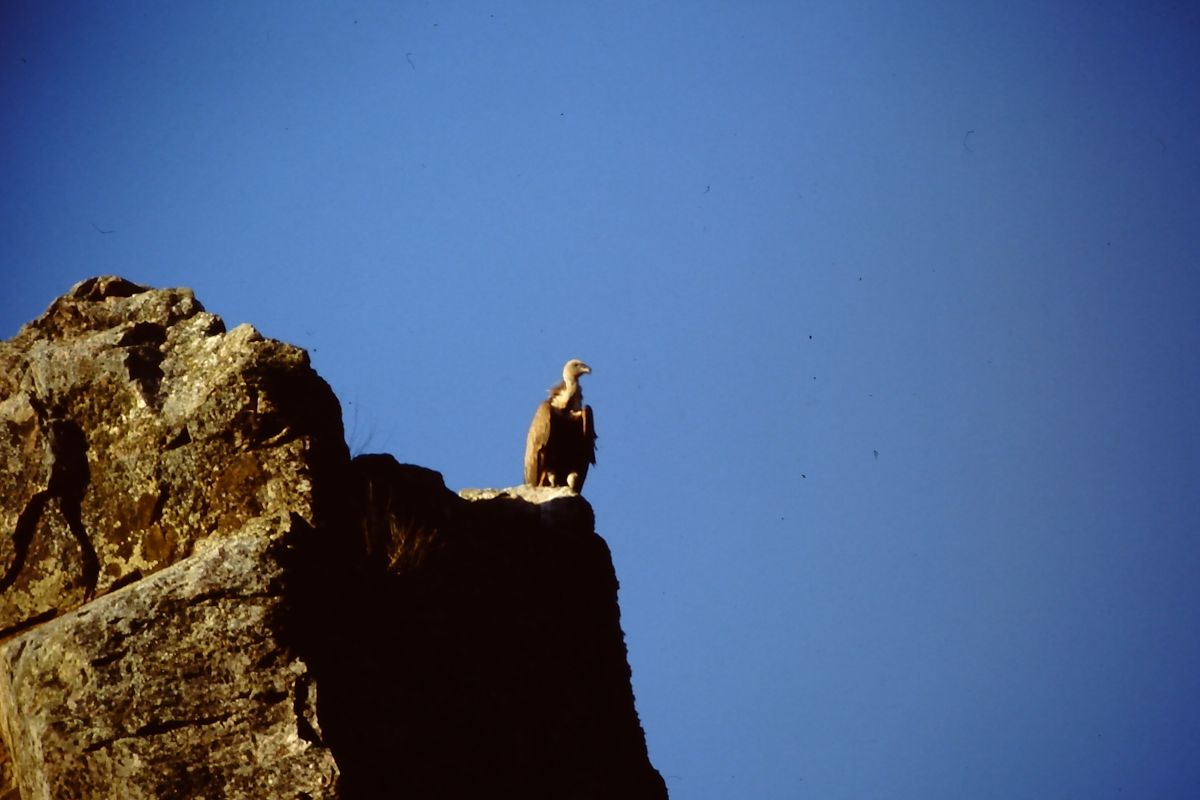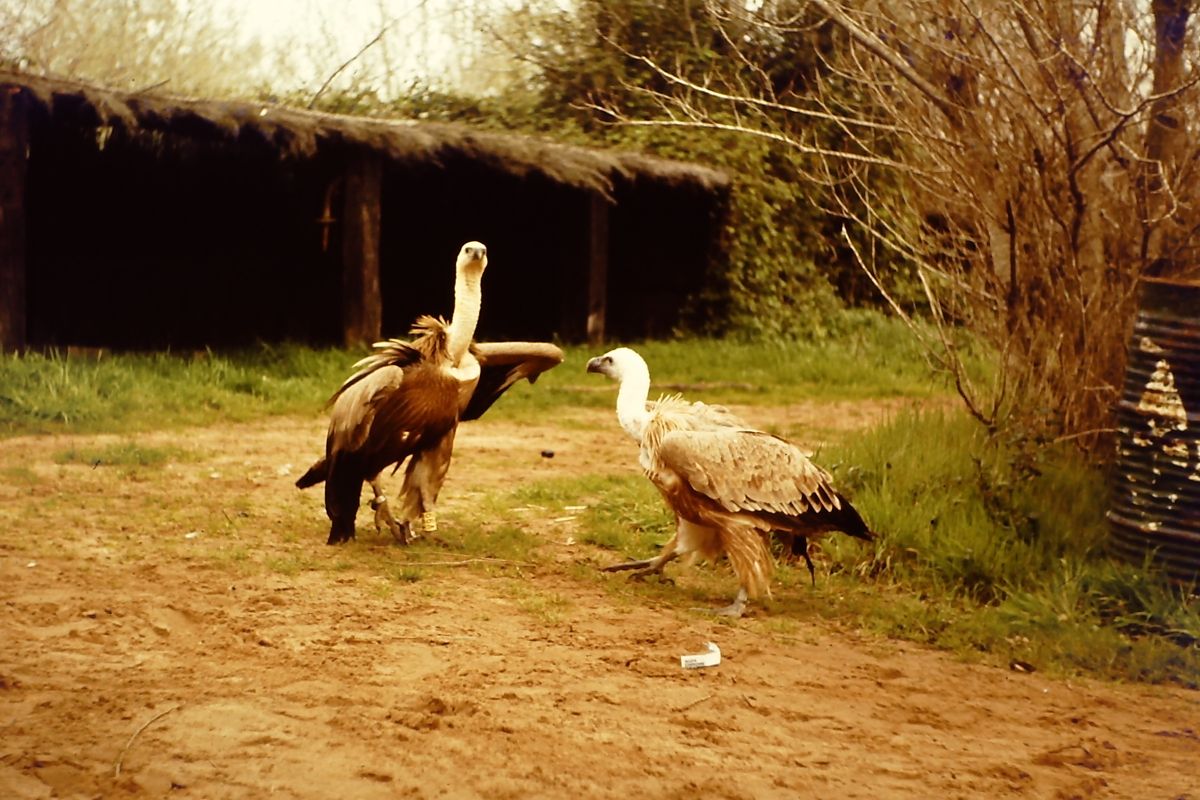Name
Gyps fulvus
Griffon vulture
Framing
Phylum: Chordata
Subphylum: Vertebrata
Class: Aves
Order: Accipitriformes
Family: Accipitridae
Genus: Gyps
Species: fulvus
Habitat
Terrestrial. Near cliffs and cliffs, where it breeds, in open forest areas, plains with river cuttings and mountains.
Feeding
It is a purely carrion-eating species, specialising in the consumption of large ungulates, both wild and - at least in our territory - domestic, which is why it is closely linked to human grazing activities. Nowadays, it also frequently frequents rubbish dumps, where it obtains abundant remains.
Distribution
Europe, Asia and North Africa
Conservation status
It does not currently meet the criteria to be assigned to any category of threat, but appears on the List of Wildlife Species under Special Protection Regime.
Additional information
Large pale-coloured vulture with a white down-covered head and neck. The griffon vulture is an immense and unmistakable bird of prey, with excellent adaptations for the detection and consumption of large carrion. With a wingspan of more than 2.5 metres and a weight of 6-9 kg, this scavenger is one of the largest birds in Europe and also one of the longest-lived. There is hardly any sexual dimorphism - apart from subtle differences hardly noticeable in the field - in terms of size and design. Adult birds have a general greyish-brown colouring, with somewhat paler dorsal regions, in contrast to the dark remiges, while the ventral regions are brownish and may be subtly striped with a lighter shade.
Additional information
Bibliography
- Alvarez, F., Arias de Reyna, L. & Hiraldo, F. (1976). Interactions among avian scavengers in southern Spain. Ornis Scandinavica, 7, 215-226.
- Araújo, M. B., Guilhaumon, F., Rodrigues Neto, D., Pozo Ortego, I. & Gómez Calmaestra, R. (2011). Impactos, vulnerabilidad y adaptación de la biodiversidad española frente al cambio climático. 2. Fauna de vertebrados. Dirección general de medio Natural y Política Forestal. Ministerio de Medio Ambiente, y Medio Rural y Marino, Madrid.
- Arroyo, B., Ferreiro, E. & Garza, V. (Eds.) (1990). II Censo Nacional de buitre leonado (Gyps fulvus): población, distribución, demografía y conservación. Instituto Nacional para la Conservación de la Naturaleza, Madrid.
- Bertrán, J., Macià, F. X. & Margalida, A. (2016). How do colonial Eurasian Griffon Vultures prevent extra-pair mating? Peerj, 4, e1749.
- Bertrán, J. & Margalida, A. (2002). Territorial behavior of bearded vultures in response to griffon vultures. Journal of Field Ornithology, 73 (1), 86-90.
- BirdLife International (2015). Gyps fulvus. The IUCN Red List of Threatened Species. Version 2015.2.
- Bosè, M., Duriez, O. & Sarrazin, F. (2012). Intra-specific competition in foraging Griffon Vultures Gyps fulvus: 1. Dynamics of group feeding. Bird Study, 59 (2), 182-192.
- Bosè, M. & Sarrazin, F. (2007). Competitive behaviour and feeding rate in a reintroduced population of Griffon Vultures, Gyps fulvus. Ibis, 149, 490-501.
- Camiña Cardenal, A. (2002). Observations of feeding Eurasian griffons Gyps fulvus in Spain. Vulture News, 46, 13-14.
- Chantepie, S., Teplitsky, C., Pavard, S., Sarrazin, F., Descaves, B., Lecuyer, P. & Robert, A. (2016). Age-related variation and temporal patterns in the survival of a long-lived scavenger. Oikos, 125 (2), 167-178.
- Cramp, S. & Simmons, K. E. L. (Eds.) (1980). Handbook of the Birds of Europe the Middle East and North Africa. The Birds of the Western Palearctic. Volume II. Hawks to Bustards. Oxford University Press, Oxford.
- De Juana, E. & Garcia, E. (2015). The Birds of the Iberian Peninsula. Christopher Helm, London.
- Del Moral, J. C. (2009). El buitre leonado en España. Población reproductora en 2008 y método de censo. Seguimiento de aves, 30. Sociedad Española de Ornitología, Madrid.
- Del Moral, J. C. & Martí, R. (Eds.) (2001). El buitre leonado en la península ibérica. SEO/BirdLife, Madrid.
- Donázar, J. A. (1993). Los buitres ibéricos. Biología y conservación. J. M. Reyero, Madrid.
- Harel, R., Horvitz, N. & Nathan, R. (2016). Adult vultures outperform juveniles in challenging thermal soaring conditions. Scientific Reports, 6, 27865.
- López-Rull, I., Hornero-Méndez, D., Frías, O. & Blanco, G. (2015). Age-Related Relationships between Innate Immunity and Plasma Carotenoids in an Obligate Avian Scavenger. Plos One, 10 (11), e0141759.
- Madroño, A., González, C. & Atienza, J. C. (Eds.) (2004). Libro rojo de las aves de España. Dirección General para la Biodiversidad - SEO/Birdlife, Madrid.
- Moreno-Opo, R., Trujillano, A. & Margalida, A. (2015). Optimization of supplementary feeding programs for European vultures depends on environmental and management factors. Ecosphere, 6 (7), 127.
- Olea, P. P. & Mateo-Tomás, P. (2009). The role of traditional farming practices in ecosystem conservation: the case of transhumance and vultures. Biological Conservation, 142 (8), 1844-1853.
- Parra, J. & Tellería, J. L. (2004). The increase in the Spanish population of griffon vulture Gyps fulvus during 1989-1999: effects of food and nest site availability. Bird Conservation International, 14 (1), 33-41.
- Slotta-Bachmayr, L., Bögel, R. & Camiña Cardenal, A. (2004). The Eurasian Griffon Vulture (Gyps fulvus) in Europe and the Mediterranean. Easteuropean/Mediterranean Griffon Vulture Workin Group, Salzburg y Madrid.



